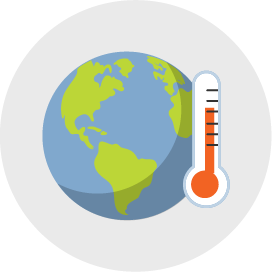Statewide conditions
As the state's lead agency for water supplies, we pay close attention to multiple data sources and monitor them closely. Rain and other precipitation, groundwater (water held in aquifers), rivers and streams, and mountain snow (snowpack) are all important contributors to water supply that we monitor.
What is water supply?
What is WSAC? 
The Water Supply Availability Committee (WSAC) is a group of experts from state and federal agencies who evaluate statewide water supply conditions. Ecology chairs this group that provides an important consultative role to Ecology. WSAC advises Ecology on current and forecasted water supply conditions and whether the hydrologic drought threshold has been met or is likely to be met: seventy-five percent of normal water supply within a geographic area (RCW 43.83B.405 and WAC 173-166-050).
If you would like to receive notices about WSAC meetings after they are posted to this page, subscribe to the Washington Water Supply Email list.
The Water Supply Availability Committee (WSAC) meets on a monthly basis. Presentation materials and recording is now available: Water Supply Availability Committee website.
Data round-up: drought conditions summary
Below is a snapshot of wide variety of data sources that helps Ecology to understand evolving drought conditions. This will be updated regulary.
The Washington State Climate Office - Climate Outlook
-
Climate Outlook: ENSO-neutral conditions are very likely (74% chance) to continue through the summer according to the Climate Prediction Center (CPC). Neutral conditions typically do not play a large role in determining our average summer weather. The CPC outlooks intensify drought concerns due to earlier than normal snowmelt for major river basins through June and increased water and electricity demands through the summer months.
-
Last updated: June 6, 2025; Next update (monthly): Late June
- 49% Statewide snowpack (Down 12% from last week), compared to normal (the 30-year average for today; info: Climate Normals | NOAA or Climatic Normals | NRCS)
- 84% Statewide water year to date precipitation (Down 2% from last week).
- SWE Interactive Map – NWCC iMap or SWE by Basin – PDF
- Last updated: June 9 , 2025; Next update (daily): June 10, 2025. (Why does “SWE” matter – USDA Factsheet).
Bureau of Reclamation (BOR)
- Yakima River system (Keechelus, Kachess, Cle Elum, Bumping, Rimrock) is at 67% of capacity and storage is at 73.4% of average (for this time of year).
-
BOR announced at a June 5 briefing a new forecast for the June-Sept period of 43% water supply for prorated irrigation districts.
-
Last updated: June 9, 2025; Next update (storage-daily): June 10, 2025. Next BOR forecast will be July 3.
Northwest River Forecast Center data and information updates:
- 10 Day Meteorological Forests – No precipitation in the next ten days. Temperatures to continue to ramp up - to hit over 80 on the Westside and over 90 in the Eastside for multiple days - with a few Eastside areas hitting over 100 Monday and Tuesday.
- Forecast report and Forecast map – Areas in North Cascades, Chelan, Okanogan/ Methow, Wenatchee, Colville, and increasing sites in the Puget Sound and Southwest, have May-Sept forecast below 75%.
- For April-September the period, the Okanagan River is forecasted at 49% of normal, Methow at 71%, Stehekin at 70%, and Chelan at 66%.
- NOTE: April – Sept forecasts are based on the next 10 days of forecast data, then based on climate Normals from 1991-2020 average.
- Lasted updated: June 9, 2025; Next update(daily): June 10, 2025.
- 8-14 day Outlook: Slight lean towards lower than normal temperature in far NW and the Olympics, with slighly lean towards above normal precipitation statewide for this portion of June.
- Valid: June 17-23, 2025, Issued: June 9, 2025
- However, the for June forecasts a higher probability of warmer than normal temperatures statewide and a slightly higher probabaillity of dryer than normal precipitation statewide, more East of the Cascades for both.
- Three month: Temperature and precipitation outlook (June-July-August) - Leaning below normal precipitation statewide and likely above normal temperature statewide.
- Last updated: Issued May 15, 2025; Next update (monthly) June 19.
National Integrated Drought Information System (NIDIS) Drought monitor
- National Drought Monitor – Now part of the South Cascades in "D1" status, with Central and North Cascades, including the Western and Eastside flanks. Full Westside, except for the very southern Cascades, and far NE are in "abnormally dry" status.
- Reminder: Tool does not account for anticipated impacts on water supply from snowpack or BOR storage.
- Updated: June 5, 2025 (U.S. Drought Monitor map is released every Thursday morning, with data valid through Tuesday at 10am PT).
United States Geological Survey (USGS) - WA Water Science Center:
- National Water Dashboard – A range of below normal, significantly low and normal flows statewide.
- Last updated: June92, 2025; Next update (daily): June 10, 2025
Other data tools used and updated:
- Odds of 2024 Water Year Precipitation Reaching 100% - As of May 1, For NW and far SE closer to 100% odds, while Central and North Cascades show odds between 25-50% for reaching 100% of normal precipitation for water year 2025.
- Climate Mapper – Updated for May - Mean Temperature & Precipitation Anomaly - Last 30 days - Higher than normal temperatures mostly statewide; Below normal precipitation statewide, especially in the Eastern Cascades.
- PRISM Palmer Drought Severity Index – Continued drought concerns for central areas of the state, including Central and North Cascades areas.
Related links
Contact information
Caroline Mellor
Statewide Drought Lead
caroline.mellor@ecy.wa.gov
360-628-4666


